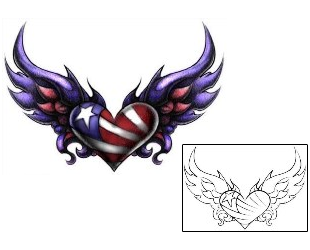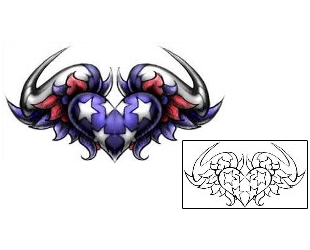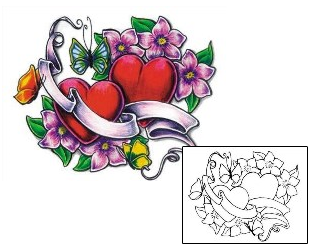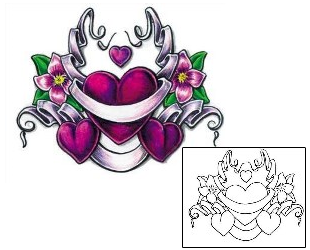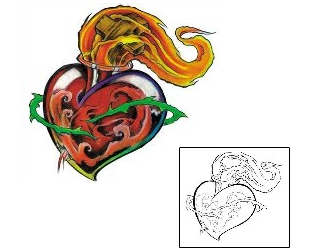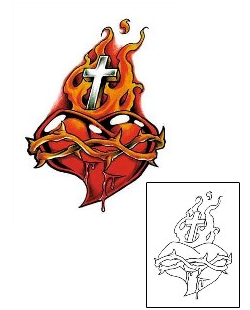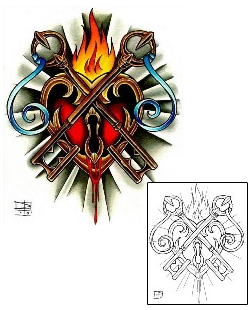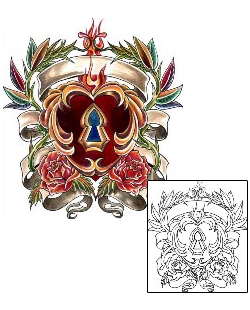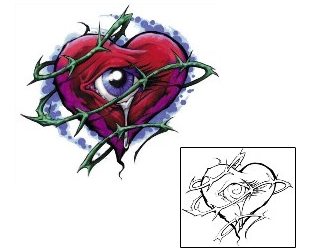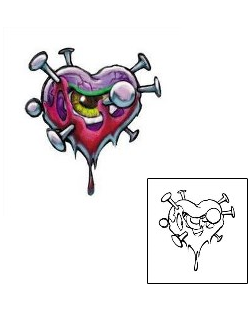As far as symbols go, the heart abounds in America. In our Western world, it has come to symbolize togetherness and love, especially love of the romantic or erotic variety. However, this is hardly a universal interpretation. The heart tattoo design has many different meanings and for those of us who choose to wear one the personal meaning is as varied as the personality of the individual who makes it their choice for a tattoo. A heart with a dagger, knife or sword can represent betrayal but can also represent courage in the face of misfortune. A heart design with wings (which looks great on a lower back) represents a joyful, optimistic and free spirit. A heart with a rose usually represents romantic love while a tribal heart rendered in black can represent emotions under control. Hearts take on new meanings when they are combined with other symbols. For example a cute heart design formed from dolphins could represent a love for dolphins and the ocean. An angel heart or a heart with a halo can represent purity of spirit.
What would the heart tattoo be without the well-known broken or bleeding heart? Sometimes pictured as half a heart, this is the symbol of lost love, primarily unrequited love, and we all know the term 'heartbroken' is used for extreme sadness and grief. Remember though, before you dash out and have a broken heart inscribed over your left breast, feelings, like all of life change. What you feel today about your lover's scorn may change quicker than you think. Heart tattoo designs can represent the warmth of spring and summer seasons and the power of light. They are the center of life and the world. In the Tarot, hearts can also symbolize knowledge, love, life from water, and fertility, and a fortune of joy. There are abundant choices for the heart tattoo design. Whichever one you choose will give you something to think about every time you look upon it.
The Heart: A Symbol Reaching to the Roots of Human History
Historians have been able to trace the heart symbol as far back as the time just prior to the last Ice Age. However, there isn't any general consensus as to what it was supposed to mean.
Later, between 600 and 400 B.C., the people of Greece used the heart symbol to designate the musical instrument known as the lyre. It also became closely associated with Eros, the god of erotic love.
The most likely reason for our own Western association between the heart symbol and romantic love can be traced back to the North African city of Cyrene in the seventh century B.C. This city had become a major (and incredibly profitable) destination on the world trade routes because of a now extinct, heart-shaped seed that was a part of the fennel family.
But why were they harvested to the point of extinction; and what does that have to do with love?
Well, this amazing little seed (which was, quite literally, worth its weight in gold) had a very beneficial side effect, it aided as an all-natural, rather easily obtainable method of birth control. It can easily be assumed that armed against the risk of yet another mouth to feed, amorous attentions could more readily be shared between couples. It's easy to understand, then, the ready connection between both the shape and its modern interpretation.
Upon the arrival of Christianity, the heart shape also began to take on a new religious significance. Early Christians, who were all fairly reliant upon using symbols to codify their then heretical faith, used the heart to symbolize the virtue of charity, a word that most biblical translations have changed to love, in the brotherly fashion. Later, there would be the Sacred Heart, an image of a wounded heart, shining with a heavenly light which came to represent Jesus Christ & His love. It became very popular during the Middle Ages, but is still used prevalently today. It can also represent unity, salvation and peace.
But Christians didn't in any sense have a monopoly on this sign. Aztecs, Hindus, Buddhists, Muslims, Jews, Celts and Taoists all give the heart symbol its own special significance. The symbol also shows up in the Voodoo arts, where it represents Erzuli, the loa (which loosely translates to spirit of love, beauty and purity. It also prevails in the cultural arts of the Asante people of Ghana, Africa. Adinkra, a hand-stitched and embroidered cloth that represented their cultural and spiritual beliefs, often used the heart symbol to show love. Whether done intentionally or not, the heart also closely resembles the Asante sign for wisdom.
From 1000 to 1400 A.D., the heart icon comes to the forefront of medieval heraldry (the insignias, crests, Coats-of-Arms and genealogical emblems) where it signifies both sincerity and clarity. It is also during this era that the heart symbol becomes intertwined with the myth and legend surrounding the Holy Grail. Believe it or not, the two items became so intertwined with one another that the earliest decks of playing cards substituted the symbol of the grail for the suit of hearts!
The Human Heart
The heart symbol didn't come to represent the human heart by ignorance. Ancient people fought bloody battles, and many had seen the throbbing, wounded organs many times across many wars. As a matter of fact, this symbol has also closely been associated with our human organ, the heart. (Remember the game Operation?) Then again, there are times when we speak of the heart, but what we mean is a mystical aura more akin to spirit than to flesh and blood. It is the abode of feelings, emotions and morals, a deeply personal and fragile being.
The ancient Egyptians believed that your heart would decide the fate of your eternal soul. Upon death, your heart is delivered to the Hall of Maat, who is the goddess of justice. It is then weighed against the goddess's tool, the Feather of Maat. If your heart was found to be as light as a feather (or, preferably lighter), you would proceed on to the afterlife with Osiris. On the other hand, if your heart was found to be too heavy, it was fated to be eaten up by the demon Ammut, causing the existence of your soul to suddenly, and forever, cease.
Across the world, in what is today Mexico, existed the Teotihuacan people; a culture that believed each human was filled with several different spiritual forces if you will, some of which were able to leave the body. Instances might include when you dreamt, or had visions. However, the teyolia, which was associated with the heart, was fated to remain inside of the body at all times, the consequence for disobedience being death.
The Marriage of Heart and Tattoo
The tattoo has matured greatly from the stereotype of the symbol on a sailor's upper arm with the word “Mom” etched across it. It would probably even be safe to say that the heart is one of the most popular tattoo designs around. They are now showing up, pink and demure, on hips and hind-ends. Or, wrapped in barbed wire across rippling muscles; or integrated with a Celtic or Tribal design.
More Heart Tattoo Ideas:
Heart shaped American Flags
Hearts & Banners
Religious & Sacred Hearts
Heart Locks & Keys
Hearts With Eyes


